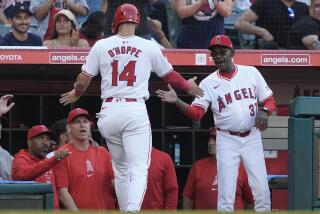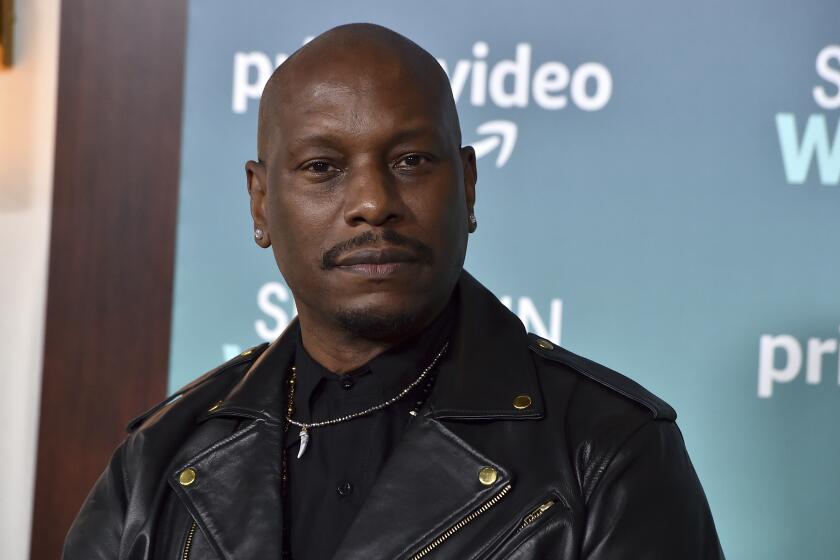A Devil of a Time for ‘Angels’ ’ Scribes
I’m probably going to lose a little money on “Charlie’s Angels.” But that’s OK--the movie’s been a bonanza for nearly every other writer in town.
Sony Pictures, desperate for a hit, managed to spend $6 million on the script for the $92-million action comedy that opens Friday. The studio didn’t give all the loot to just one lucky stiff; it spread the wealth. Although only three writers have script credit, 17 writers ended up working on the movie, including six “Seinfeld” and “Larry Sanders Show” vets who did a round-table joke writing session just before it went into production.
Never has so much top-flight talent been put to work on such a trifle--it’s like asking Bono and Beck to write songs for the Backstreet Boys. The Six Million Dollar Screen Team includes such A-list screenwriters as Ed Solomon (“Men in Black”), Robert Harling (“First Wives Club”), Akiva Goldsman (“Batman Forever”), Susannah Grant (“Erin Brockovich”), Zak Penn (“Antz”) and Mitch Glazer (“Great Expectations”).
The tag-team approach to making the movie wasn’t limited to just writers; the film also had three sets of producers, including original “Charlie’s Angels” TV producer Leonard Goldberg, co-star Drew Barrymore and “28 Days” producer Jenno Topping.
“It was a hellish experience,” says one of the screenwriters. “There was a lot of grasping at straws, which is why so many writers came and went. It was a mess from start to finish--if Jenno hadn’t come in, we’d probably still be shooting the movie.”
No one’s saying the film won’t open big. It’s playing well with teen moviegoers in previews. That’s where I’m in the hole. I have an over-under opening weekend bet with a Sony executive (I’m taking under $29 million) that I suspect I’ll lose, since the current tracking numbers--pre-release marketing surveys of moviegoers--have the movie opening at $33 million. But I’m still betting that the road to riches will be rough; bad reviews and the technobabble action scenes may keep the movie from crossing over to the adult audience it will need to make a sizable profit.
Why did a movie like “Charlie’s Angels” end up with enough screenwriters to screw in all the lightbulbs at the El Capitan Theater? Let’s go back to the beginning.
*
The idea for reviving the late ‘70s TV show about three crime-fighting babes came in the mid-’90s from Goldberg. After seeing how well movie versions of TV shows like “The Fugitive” did at the box office, he went to Sony, then run by Mark Canton, and proposed doing a film version of the show (which Sony owned through its acquisition of Goldberg and Aaron Spelling’s TV company).
Sony hired Carol Wolper to write the first script, largely because she’d just done a well-received rewrite on the 1995 hit, “Bad Boys.”
“I said, ‘If you want some cute James Bond-type genre spoof, you’ve come to the wrong person,’ ” Wolper recalls. “I’m going to write a movie where they aren’t going to just wave a gun and say, ‘Freeze!’ They’re really going to shoot it.”
By the time she turned in her script, Canton was gone and Amy Pascal was in. The new studio chief wanted more of a tongue-in-cheek film and turned to Ryan Rowe and Solomon, old college friends from UCLA. Solomon was especially valued for having written “Men in Black,” a blockbuster whose cheeky tone the studio was supposedly looking for.
The writers delivered a finished script in July 1998. It featured a brainy trio of Angels who could lip-read any language, outfight any guy and traversed the globe in their quest to rescue a flock of kidnapped supermodels--a Bond-style action thriller, played for laughs.
The script got Barrymore attached to the movie. But Sony couldn’t get A-list directors interested. “It was a no-win situation,” explains Goldberg. “It certainly wasn’t an Oscar movie, yet everyone already had such commercial expectations for the picture that if you didn’t deliver a hit, you’d look like a failure.”
Barrymore and her producing partner, Nancy Juvonen, brought on John August, who’d written “Go,” a film viewed as having youth-culture cool even though it was a box-office dud. August kept the setup from the Rowe-Solomon script but trimmed the globetrotting scenes, focusing the story in Southern California, with more “Matrix”-style action for the individual Angels.
“I called Sony and said, ‘Have you ever seen the show?’ ” recalls Juvonen. “It’s all about America, but the first script has the Angels in a castle in Europe in snow bunny outfits.” The supermodel subplot was out too, for a combination of movie-star vanity and common sense reasons. As Juvonen put it: “The models are totally alienating, just by their looks. They’re taller and more beautiful. Why risk the Angels not being the most popular ones in the room?”
As actress-producer, Barrymore became an influential decision-maker on the set. She picked August, lobbied for first-time director McG, best known for his GAP Country TV ads, and wooed key cast members, including co-Angel Cameron Diaz. However, Barrymore and Juvonen had no experience doing a big-budget project, and by the fall of 1999 the movie was floundering, beset by production delays. Lucy Liu wasn’t hired until late November. The script’s third act still didn’t play.
To get things moving, the studio brought in Topping and her producing partner, director Betty Thomas, so the film could start shooting in January--finished script or not. Everyone agrees that it’s a bad idea to make a movie without a completed script, but in Hollywood, actors are more valued than finished scripts. If the movie didn’t start right away, Barrymore and Diaz would’ve been lost to other films. To make matters worse, August had to leave to do a TV pilot.
*
That’s when the flood of writers began. The studio brought in Penn, who spent three weeks working on structure. Barrymore and Juvonen got Steve Pink and D.V. DeVincentis (“High Fidelity”) to do three weeks of work. Topping had Susannah Grant, who’d written “28 Days” for her and Thomas, come in to pen material for the actresses. Sony also brought in Robert Harling, who wrote Diaz’s “Soul Train” booty-wiggling sequence and other comic material for “Angels.”
“I gave up my Christmas and millennium for ‘Charlie’s Angels,’ ” says Harling, who finished his work from his home in Louisiana. “I was still shoving pages into my fax machine the Friday before they went into production. It’s a little like laying track in front of a freight train.”
Most of the hired guns earned $100,000 a week or more; however, Solomon, Rowe and August are the only writers who get screen credit on the picture. But even after shooting began in January, the movie still had no ending.
Akiva Goldsman came in for three weeks of work. Then Mitch Glazer, a close friend of Bill Murray, who plays Bosley, spent two months working on the third act, as well as scenes with Murray and Kelly Lynch, Glazer’s wife, who plays a sexy villainess in the picture.
With a jittery studio hiring writers left and right while the stars tried out dialogue of their own, it was a chaotic production. “When you have so much tension making a movie, it’s inevitable that there’ll be conflicts,” says Topping. “We all had arguments. But mountains were made out of molehills. I remember my mother called from Long Island, saying, ‘I’ve heard about trouble on the set,’ and I kept thinking, ‘Even she knows that?’ ”
Juvonen admits that there were days when decisions were made by having “12 people in a room and us saying, ‘Raise your hands and let’s see who wins.’ ”
Films are a collaborative art, but they are not a democracy: They need a Big Kahuna to make the tough calls. Producer Jerry Bruckheimer uses dozens of writers on his action films, but no one ever works at cross purposes--he’s the boss.
“Things would’ve gone smoother if there had been one person who could’ve been in control,” says Columbia Pictures chairman Amy Pascal. “But with some movies, that person doesn’t exist. Don’t worry, this movie is going to be a big hit. Just watch, we’re going to be making sequels.”
Maybe so, but the more you tinker with a script, the more it spirals downward from smart to dumb. Just ask Solomon, who jokes that he and Rowe wrote everything in the film except the plot, the characters and the dialogue.
“What’s important isn’t how many writers work on a movie but that the movie has a unified vision,” says Solomon. “You wouldn’t design a building by having Richard Meier do one segment, Frank Gehry do the next and I.M. Pei do the next. Not only would it end up being a weird looking building, but you can bet the elevator wouldn’t go from floor to floor.”
For all its high-tech computer lingo and top-secret voice identification software, it’s a dim bulb of a movie. No wonder it evokes such modesty from its screenwriters. As one wryly confided: “I don’t think I have one line of dialogue in the finished script--at least not one I’m willing to take credit for.”
*
Patrick Goldstein’s column, “The Big Picture,” will run every Tuesday in Calendar. If you have questions, criticism or ideas, e-mail them to patrick.goldstein@latimes.com.
More to Read
Only good movies
Get the Indie Focus newsletter, Mark Olsen's weekly guide to the world of cinema.
You may occasionally receive promotional content from the Los Angeles Times.










